Single Trench Fiber-Enabled High-Power Fiber Laser
Abstract
:1. Introduction
2. Fiber Design and Fabrication
2.1. Fiber Design
2.2. Fiber Fabrication
3. Experimental Setup
4. Experimental Results and Discussion
5. Conclusions
Author Contributions
Funding
Institutional Review Board Statement
Informed Consent Statement
Data Availability Statement
Conflicts of Interest
References
- Bai, H.; Li, S.; Barreiros, J.; Tu, Y.; Pollock, C.R.; Shepherd, R.F. Stretchable distributed fiber-optic sensors. Science 2020, 370, 848–852. [Google Scholar] [CrossRef] [PubMed]
- Abouraddy, A.F.; Bayindir, M.; Benoit, G.; Hart, S.D.; Kuriki, K.; Orf, N.; Shapira, O.; Sorin, F.; Temelkuran, B.; Fink, Y. Towards multimaterial multifunctional fibres that see, hear, sense and communicate. Nat. Mater. 2007, 6, 336–347. [Google Scholar] [CrossRef]
- Xiong, Y.F.; Xu, F. Multifunctional integration on optical fiber tips: Challenges and opportunities. Adv. Photonics 2020, 2, 064001. [Google Scholar] [CrossRef]
- Saitoh, K.; Matsuo, S. Multicore Fiber Technology. J. Light. Technol. 2016, 34, 55–66. [Google Scholar] [CrossRef]
- Anashkina, E.A.; Andrianov, A.V.; Litvak, A.G. Numerical Simulation of High-Power Optical Amplifiers at 2.3 µm Based on a Special Multicore Fiber. Photonics 2023, 10, 711. [Google Scholar] [CrossRef]
- Garcia, S.; Gasulla, I. Universal characteristic equation for multi-layer optical fibers. IEEE J. Sel. Top. Quantum. 2020, 26, 1–11. [Google Scholar] [CrossRef]
- Gao, S.F.; Wang, Y.Y.; Ding, W.; Jiang, D.L.; Gu, S.; Zhang, X.; Wang, P. Hollow-core conjoined-tube negative-curvature fibre with ultralow loss. Nat. Commun. 2018, 9, 2828. [Google Scholar] [CrossRef]
- Russell, P. Photonic crystal fibers. Science 2003, 299, 358–362. [Google Scholar] [CrossRef]
- Skibina, J.S.; Iliew, R.; Bethge, J.; Bock, M.; Fischer, D.; Beloglasov, V.I.; Wedell, R.; Steinmeyer, G. A chirped photonic-crystal fibre. Nat. Photonics 2008, 2, 679–683. [Google Scholar] [CrossRef]
- Tang, Z.W.; Zheng, Z.H.; Li, B.Y.; Wei, Z.Y.; Sun, J.H. Applications of Microstructured Optical Fibers in Ultrafast Optics: A Review. Photonics 2024, 11, 151. [Google Scholar] [CrossRef]
- Richardson, D.J.; Fini, J.M.; Nelson, L.E. Space-division multiplexing in optical fibres. Nat. Photonics 2013, 7, 354–362. [Google Scholar] [CrossRef]
- Chen, J.H.; Li, D.R.; Xu, F. Optical Microfiber Sensors: Sensing Mechanisms, and Recent Advances. J. Light. Technol. 2019, 37, 2577–2589. [Google Scholar] [CrossRef]
- Liu, Z.; Zhang, Z.F.; Tam, H.-Y.; Tao, X. Multifunctional Smart Optical Fibers: Materials, Fabrication, and Sensing Applications. Photonics 2019, 6, 48. [Google Scholar] [CrossRef]
- Stellinga, D.; Phillips, D.B.; Mekhail, S.P.; Selyem, A.; Turtaev, S.; Cizmar, T.; Padgett, M.J. Time-of-flight 3D imaging through multimode optical fibers. Science 2021, 374, 1395–1399. [Google Scholar] [CrossRef] [PubMed]
- Nilsson, J.; Payne, D.N. High-power fiber lasers. Science 2011, 332, 921–922. [Google Scholar] [CrossRef] [PubMed]
- Zervas, M.N.; Codemard, C.A. High Power Fiber Lasers: A Review. IEEE J. Sel. Top. Quantum. 2014, 20, 219–241. [Google Scholar] [CrossRef]
- Jauregui, C.; Limpert, J.; Tünnermann, A. High-power fibre lasers. Nat. Photonics 2013, 7, 861–867. [Google Scholar] [CrossRef]
- Jain, D.; Jung, Y.; Nunezvelazquez, M.; Sahu, J.K. Extending single mode performance of all-solid large-mode-area single trench fiber. Opt. Express 2014, 22, 31078–31091. [Google Scholar] [CrossRef] [PubMed]
- Jain, D.; Alam, S.; Jung, Y.; Barua, P.; Velazquez, M.N.; Sahu, J.K. Highly efficient Yb-free Er-La-Al doped ultra-low NA large mode area single-trench fiber laser. Opt. Express 2015, 23, 28282–28287. [Google Scholar] [CrossRef]
- Jain, D.; Sahu, J.K. Large mode area single trench fiber for 2 μm operation. J. Light. Technol. 2016, 34, 3412–3417. [Google Scholar] [CrossRef]
- An, Y.; Yang, H.; Chen, X.; Huang, L.J.; Yan, Z.P.; Pan, Z.Y.; Wang, Z.F.; Jiang, Z.F.; Zhou, P. Seeing the strong suppression of higher order modes in single trench fiber using the S2 technique. Opt. Lett. 2023, 48, 61–64. [Google Scholar] [CrossRef] [PubMed]
- Fini, J.M. Design of solid and microstructure fibers for suppression of higher-order modes. Opt. Express 2005, 13, 3477–3490. [Google Scholar] [CrossRef] [PubMed]
- Jain, D.; Alam, S.; Codemard, C.; Jung, Y.; Zervas, M.N.; Sahu, J.K. High power, compact, picosecond MOPA based on single trench fiber with single polarized diffraction-limited output. Opt. Lett. 2015, 40, 4150–4153. [Google Scholar] [CrossRef] [PubMed]
- Huang, L.J.; Yao, T.F.; Yang, B.H.; Leng, J.Y.; Zhou, P.; Pan, Z.Y.; Gu, S.Y.; Cheng, X.A. Modified single trench fiber with effective single-mode operation for high-power application. IEEE J. Sel. Top. Quantum. 2018, 24, 0901409. [Google Scholar] [CrossRef]
- An, Y.; Chen, Y.S.; Xiao, H.; Wu, H.S.; Chen, X.; Yang, H.; Yan, Z.P.; Huang, L.J.; Leng, J.Y.; Pan, Z.Y.; et al. 1.5 kW fiber amplifier employing home-made large-mode-area single trench fiber. In Proceedings of the Eighth Symposium on Novel Photoelectronic Detection Technology and Applications, Kunming, China, 7–9 December 2021; p. 121694R. [Google Scholar]
- Li, M.J.; Chen, X.; Liu, A.P.; Gray, S.; Wang, J.; Walton, D.T.; Zenteno, L.A. Limit of effective area for single-mode operation in step-index large mode area laser fibers. J. Light. Technol. 2009, 27, 3010–3016. [Google Scholar] [CrossRef]
- Xing, Z.; Wang, X.; Lou, S.Q.; Zhang, W.; Tang, Z.J.; Yan, S.B. Bend resistant large mode area fiber with step-index core and single trench. Opt. Fiber Technol. 2019, 48, 15–21. [Google Scholar] [CrossRef]
- Kim, J.; Dupriez, P.; Codemard, C.; Nilsson, J.; Sahu, J.K. Suppression of stimulated Raman scattering in a high power Yb-doped fiber amplifier using a W-type core with fundamental mode cut-off. Opt. Express 2006, 14, 5103–5113. [Google Scholar] [CrossRef] [PubMed]
- Kobyakov, A.; Sauer, M.; Chowdhury, D. Stimulated brillouin scattering in optical fibers. Adv. Opt. Photonics 2010, 2, 1–59. [Google Scholar] [CrossRef]
- Stutzki, F.; Jansen, F.; Otto, H.-J.; Jauregui, C.; Limpert, J.; Tünnermann, A. Designing advanced very-large-mode-area fibers for power scaling of fiber-laser systems. Optica 2014, 1, 233–242. [Google Scholar] [CrossRef]
- Bufetova, G.; Kosolapov, A.; Yashkov, M.; Umnikov, A.; Velmiskin, V.; Tsvetkov, V.; Bufetov, I. Extra-High Pressure in the Core of Silica-Based Optical Fiber Preforms during the Manufacturing Process. Photonics 2023, 10, 335. [Google Scholar] [CrossRef]
- Tao, R.M.; Ma, P.F.; Wang, X.L.; Zhou, P.; Liu, Z.J. 1.3 kW monolithic linearly polarized single-mode master oscillator power amplifier and strategies for mitigating mode instabilities. Photonics Res. 2015, 3, 86–93. [Google Scholar] [CrossRef]
- Tao, R.M.; Wang, X.L.; Zhou, P. Comprehensive theoretical study of mode instability in high-power fiber lasers by employing a universal model and its implications. IEEE J. Sel. Top. Quantum. 2018, 24, 1–19. [Google Scholar] [CrossRef]
- Jauregui, C.; Stihler, C.; Limpert, J. Transverse mode instability. Adv. Opt. Photonics 2020, 12, 429–484. [Google Scholar] [CrossRef]
- Ward, B. Theory and modeling of photodarkening-induced quasi static degradation in fiber amplifiers. Opt. Express 2016, 24, 3488–3501. [Google Scholar] [CrossRef] [PubMed]
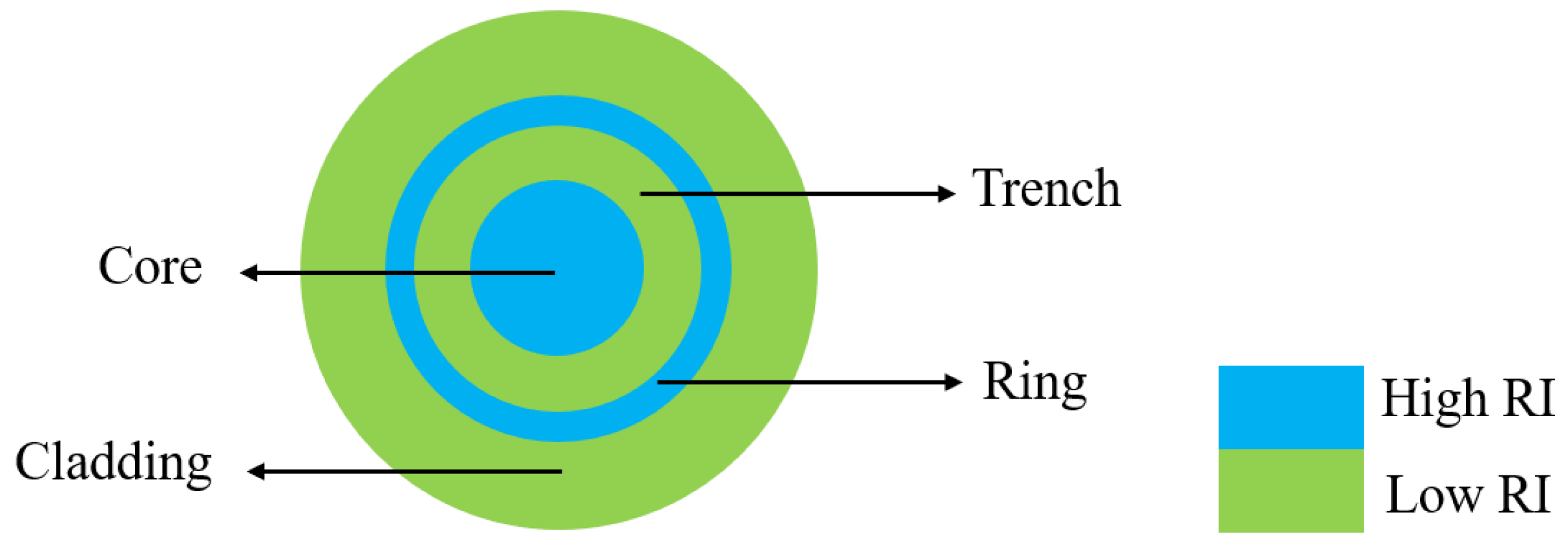

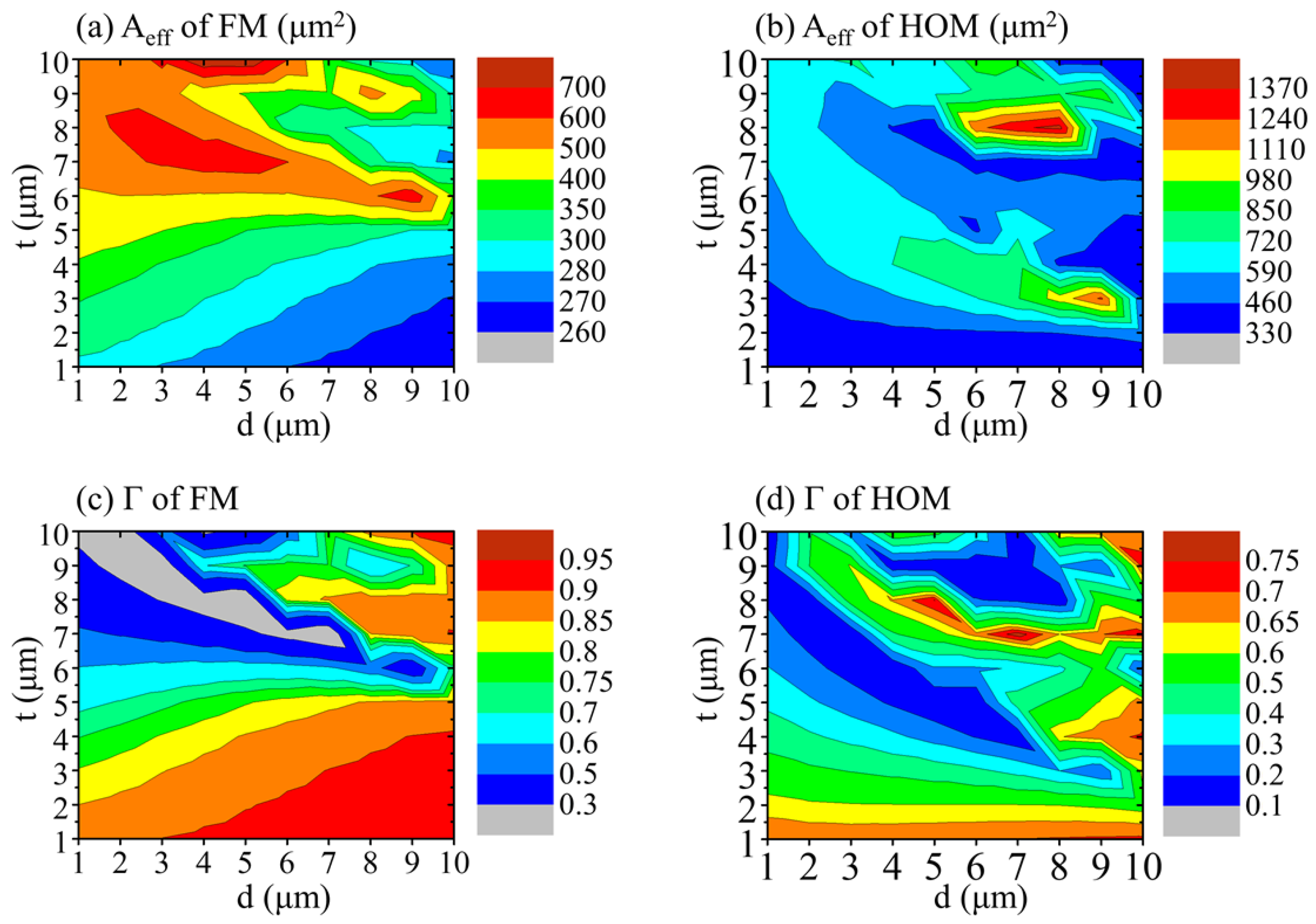
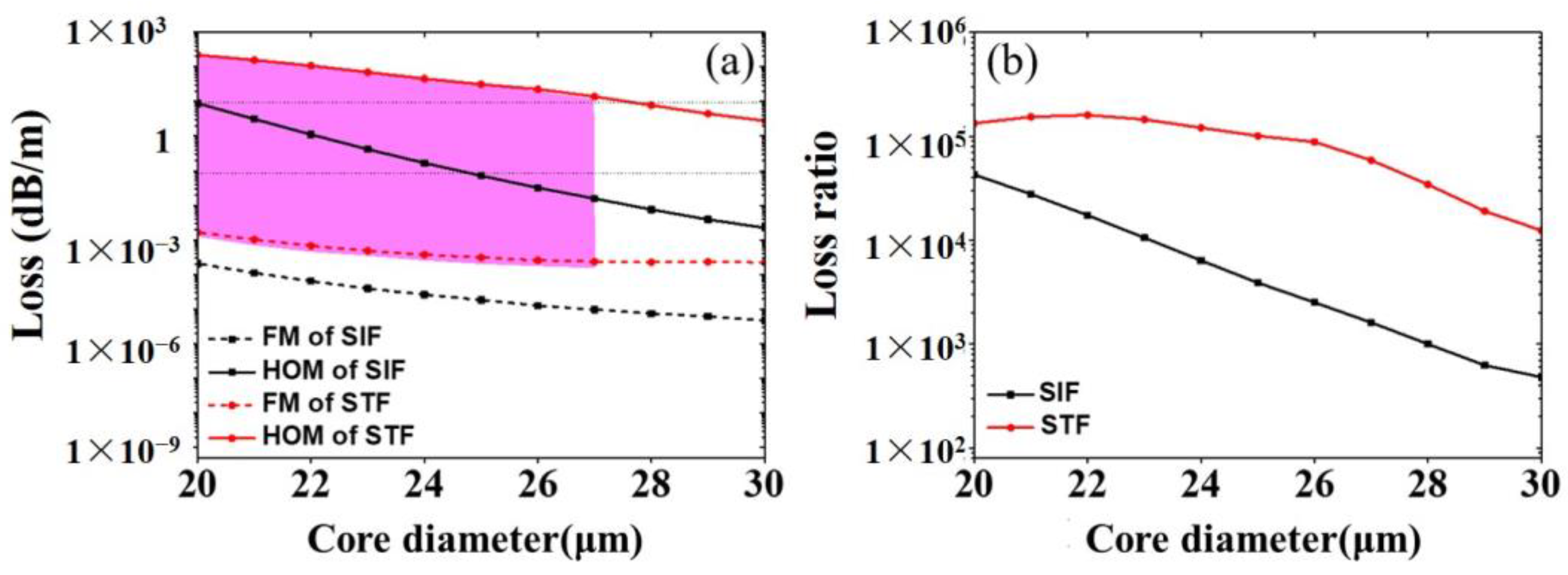

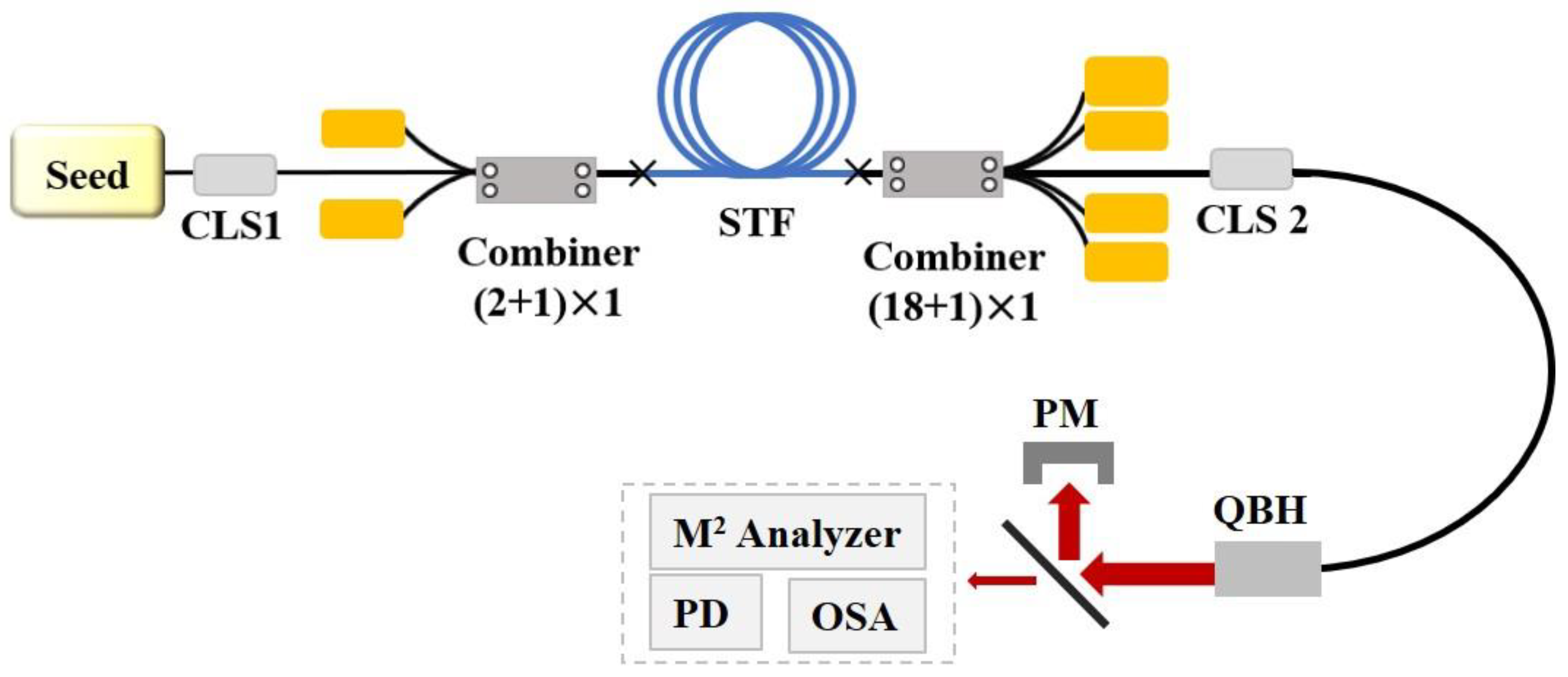
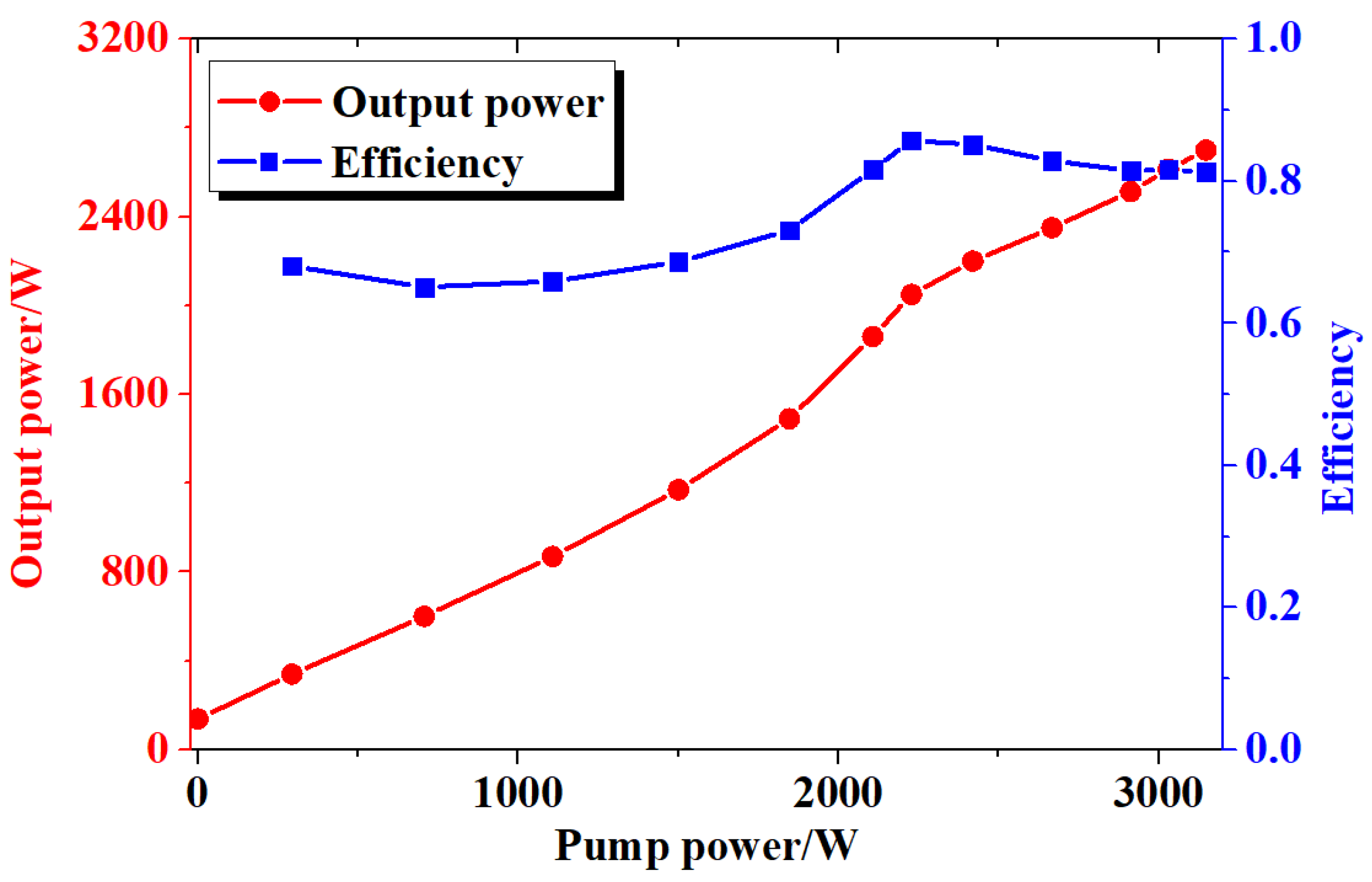
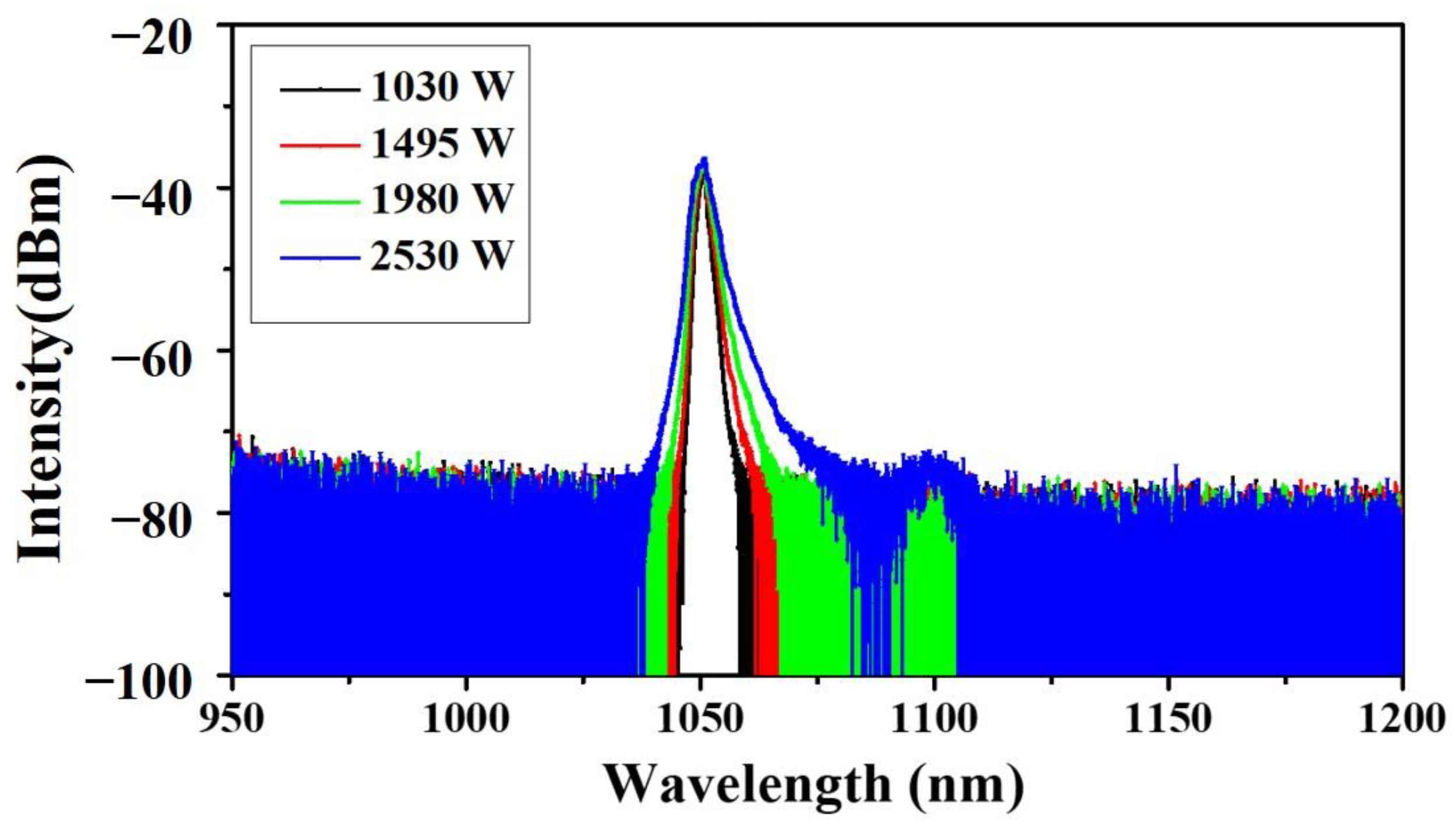

| Bending Radius (Input-Maximum-Output) | Seed Number (Power@Wavelength) | Pumping Direction | O-O Efficiency | TMI Threshold | Beam Quality (M2@Power) |
|---|---|---|---|---|---|
| 8.0-9.8-8.4 cm | #1:140W@1050nm | Backward | 65~85% | 2.70 kW | 1.33@1.5 kW 1.36@2.0 kW 1.40@2.5 kW |
| 8.0-9.8-8.4 cm | #2:103W@1080nm | Backward | 66~84% | 1.97 kW | 1.42@1.6 kW 1.44@1.9 kW |
| Bidirectional | 67~79% | 3.08 kW | 1.48@2.5 kW 1.60@3.0 kW | ||
| 8.0-9.8-8.4 cm | #3:103W@1080nm | Backward | 60~83% | 1.99 kW | 1.32@1.5 kW 1.36@1.9 kW |
| Bidirectional | 67~77% | 3.05 kW | 1.41@2.0 kW 1.48@2.5 kW 1.61@3.0 kW | ||
| 9.3-9.8-7.0 cm | #3:103W@1080nm | Backward | 62~86% | 2.12 kW | 1.32@1.5 kW |
| Bidirectional | 66~79% | 3.27 kW | 1.44@2.1 kW 1.52@2.6 kW 1.67@3.0 kW 1.77@3.2 kW |
Disclaimer/Publisher’s Note: The statements, opinions and data contained in all publications are solely those of the individual author(s) and contributor(s) and not of MDPI and/or the editor(s). MDPI and/or the editor(s) disclaim responsibility for any injury to people or property resulting from any ideas, methods, instructions or products referred to in the content. |
© 2024 by the authors. Licensee MDPI, Basel, Switzerland. This article is an open access article distributed under the terms and conditions of the Creative Commons Attribution (CC BY) license (https://creativecommons.org/licenses/by/4.0/).
Share and Cite
An, Y.; Li, F.; Yang, H.; Chen, X.; Huang, L.; Yan, Z.; Jiang, M.; Yang, B.; Wang, P.; Pan, Z.; et al. Single Trench Fiber-Enabled High-Power Fiber Laser. Photonics 2024, 11, 615. https://doi.org/10.3390/photonics11070615
An Y, Li F, Yang H, Chen X, Huang L, Yan Z, Jiang M, Yang B, Wang P, Pan Z, et al. Single Trench Fiber-Enabled High-Power Fiber Laser. Photonics. 2024; 11(7):615. https://doi.org/10.3390/photonics11070615
Chicago/Turabian StyleAn, Yi, Fengchang Li, Huan Yang, Xiao Chen, Liangjin Huang, Zhiping Yan, Min Jiang, Baolai Yang, Peng Wang, Zhiyong Pan, and et al. 2024. "Single Trench Fiber-Enabled High-Power Fiber Laser" Photonics 11, no. 7: 615. https://doi.org/10.3390/photonics11070615
APA StyleAn, Y., Li, F., Yang, H., Chen, X., Huang, L., Yan, Z., Jiang, M., Yang, B., Wang, P., Pan, Z., Jiang, Z., & Zhou, P. (2024). Single Trench Fiber-Enabled High-Power Fiber Laser. Photonics, 11(7), 615. https://doi.org/10.3390/photonics11070615





